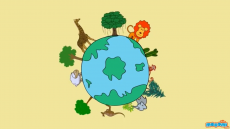

GCSE BIOLOGY REVISION: BIODIVERSITY AND THE EFFECT OF HUMAN INTERACTION ON ECOSYSTEM
Please note: Text in bold is what the AQA GCSE biology specification requires an understanding of.
Humans reduce the amount of land available for other animals and plants by building, quarrying, farming and dumping waste.
The destruction of peat bogs, and other areas of peat to produce garden compost, reduces the area of this habitat and thus the variety of different plant, animal and microorganism species that live there (biodiversity).
What are peat bogs? A bog is a wetland that accumulates peat, a deposit of dead plant material (often mosses.) In most cases, sphagnum moss. These mosses are acidic and often have very low levels of nutrients. Peat formation occurs because decomposition is slow.
For many years peat bogs have been destroyed to make garden compost. They would be added to soil or burned as duel. This dramatically reduced biodiversity. Peat takes a very long time to form, it is therefore a non-renewable energy resource like fossil fuels.
The decay or burning of the peat releases carbon dioxide into the atmosphere.
Peat bogs are a highly important carbon store, named carbon sinks. If all the peat was removed and burned this would lead to an extreme increase of atmospheric carbon dioxide levels massively contributing to the greenhouse gas effect and global warming.
Understand the conflict between the need for cheap available compost to increase food production and the need to conserve peat bogs and peatlands as habitats for biodiversity and to reduce carbon dioxide emissions.
Here in the specification you will be expected to be able to interpret given information, drawing out the positives and negatives and perhaps making conclusions. Additionally, you will need to know some example answers of conflict.
The need for conservation: maintaining biodiversity, reducing carbon dioxide emissions, a sustainable environment for future generations. Make sure you can explain what the negatives are.
The need for cheap available compost- to increase food production, enriching the soil for plant growth, help retain moisture, meet human demands.
The number of marks available will determine how you should answer this question. If it is worth a lot of marks (perhaps 6) then you will need to explain points given clearly using the appropriate terminology. Smaller questions may only expect a few words.
Large-scale deforestation in tropical areas has occurred to:
provide land for cattle and rice fields
grow crops for biofuels.
Evaluate the environmental implications of deforestation.
Deforestation destroys the habitats of organisms that live there, and kills many individuals. Scientists estimate that several hundred species have been lost due to deforestation, thus reducing biodiversity. For thousands of years humans have been cutting down trees and destroying land for human development, this has risen with human population increase. A large contributor is companies who deforest to provide land for cattle, rice fields and growing crops for biofuels.
image-https://www.youtube.com/watch?v=ErATB1aMiSU

0 Comment:
Be the first one to comment on this article.